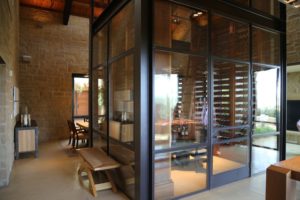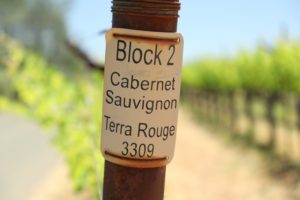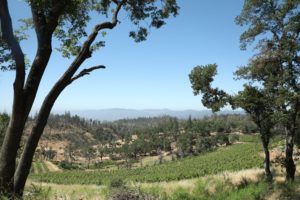
 O’Shaughnessy Winery is located on a beautiful property well off the “beaten path” north east of the small town of Angwin on the slopes of Howell Mountain. Fairly isolated in its geographic location, a visit here is worth the drive. Seemingly located in the middle of nowhere, in actuality it is only about 10 minutes from Angwin, a prominent 7th Day Adventist community whose members do not drink alcohol.
O’Shaughnessy Winery is located on a beautiful property well off the “beaten path” north east of the small town of Angwin on the slopes of Howell Mountain. Fairly isolated in its geographic location, a visit here is worth the drive. Seemingly located in the middle of nowhere, in actuality it is only about 10 minutes from Angwin, a prominent 7th Day Adventist community whose members do not drink alcohol.
Founder, Betty O’Shaughnessy Woolls, is originally from Minnesota where she worked in real estate investment and development in Minneapolis. She was also owner and teacher of Mrs. O’s Cooking School in Minneapolis. She came to Napa Valley in 1990 and settled in Oakville. Today Betty owns O’Shaughnessy Winery with her husband Paul Wools.

 Betty is a strong supporter of the Aldea Foundation, an organization based in the city of Napa that focuses on improving people’s mental health and provides child welfare and support services.
Betty is a strong supporter of the Aldea Foundation, an organization based in the city of Napa that focuses on improving people’s mental health and provides child welfare and support services.
Paul traces his interest in wine back to Roswell New Mexico, “not a wine capital of the world by any means”, as he told us. He was 15 years old and sampled a number of cheap wines but found they all tasted pretty much the same – sweet and with bubbles. Fast forward to the early 1980s when he was practicing law in Philadelphia; he met a collector, Robert Perna who Paul describes as “more interested in educating people about wine then making money”. Robert offered classes under the name L’ecole de Vins (The Wine School, in English) – Paul took a number of these classes and quickly broadened his international wine education and palate.
O’Shaughnessy produced its first commercial vintage in 2000. The winery harvests grapes from 18 different varieties from four unique vineyard locations within Napa Valley, all under their ownership.
Betty purchased three parcels from the prior owner; today they are part of one contiguous property. From the winery, one can only see a portion of their estate vineyard; 45 acres of the 120 total acres are planted to grapes including the majority to Cabernet Sauvignon. This vineyard was originally developed and planted by Pina Vineyard Management between 1997 and 2002. Since 2008 O’Shaughnessy farms all their vineyards with an in-house vineyard management team.
The vineyard features three distinctive blocks; Amphitheater Vineyard named for its geographical feature, Rancho Del Oso, named after a local black bear and the Osprey’s Nest Vineyard. Howell Mountain is generally above the fog; it often creeps up the nearby canyon but stops just below their property. It is rare when it rises above their vineyards.
Their Oakville Vineyard is located in the heart of this appellation on Oakville Cross Road almost directly across from B Cellars Winery. This was Betty’s initial purchase in Napa Valley; today it is 32 acres and includes two varieties not often seen growing in Oakville: Sauvignon Blanc and Chardonnay along with Cabernet Sauvignon.
They own two vineyard sites on Mt. Veeder, a 55-acre property home to Betty’s Vineyard which Betty purchased in 2000; today approximately 17 acres are planted entirely to Cabernet Sauvignon. This vineyard used to be planted to a small section of Syrah; stand alone bottlings of Syrah were produced in 2006 and 2010. And the 265-acre Woolls Ranch, home of Progeny Winery is planted to 32 acres of vines including Cabernet Franc, several other Bordeaux red blending varieties and several white and red Rhone varieties.
O’Shaughnessy manages several extremely rare plantings in Napa Valley; they grow small amounts of three of Bordeaux’s little known red varieties, Carménère (today most known for being grown in Chile), Gros Verdot and St. Macaire; to the best of our knowledge, this is the only winery in Napa growing Gros Verdot and St. Macaire.
Gros Verdot is a fairly obscure red variety that was historically most associated with the Gironde region of Bordeaux but has been banned from Bordeaux since 1946. It is known for an inherent peppery character and sometimes an unusual for a red variety, an aroma or flavor similar to grapefruit. And St. Macaire is such an obscure variety these days it is difficult to even find vineyard sources. It takes its name from a small medieval village about a 45-minute drive southeast of Bordeaux.
The O’Shaughnessy wines are always balanced and highlight the purity and ripeness of fruit but without ever being overly extracted or over ripe. Tannin management (including through blending) is an important part of their ethos in both the vineyard and cellar. As a result these are wines ready to drink in their youth but are also age-worthy and food friendly. And every one of their wines are distinctive, as they should be, representative of the terroir differences in each of their vineyards.
Select Wines
Whites


 Any white wines from Oakville certainly piques our interest, since this sub appellation is known for its bold reds. O’Shaughnessy grows 17 acres of Sauvignon Blanc and 3 acres of Chardonnay at their Oakville property. Winemaker Aaron Elam enjoys working with white wines from Oakville especially in terms of dialing in a balanced acidity from a warmer growing region. And with the Chardonnay in particular he has noticed a commonality in terms of aromas, flavor and texture regardless of vintage. The O’Shaughnessy white wines are produced at Progeny Winery.
Any white wines from Oakville certainly piques our interest, since this sub appellation is known for its bold reds. O’Shaughnessy grows 17 acres of Sauvignon Blanc and 3 acres of Chardonnay at their Oakville property. Winemaker Aaron Elam enjoys working with white wines from Oakville especially in terms of dialing in a balanced acidity from a warmer growing region. And with the Chardonnay in particular he has noticed a commonality in terms of aromas, flavor and texture regardless of vintage. The O’Shaughnessy white wines are produced at Progeny Winery.
The 2022 O’Shaughnessy Estate Children’s Garden Sauvignon Blanc Oakville is pale gold in color; the bouquet is lively and simultaneously aromatic with scents of citrus blossom, pineapple and light vanilla. The palate offers an initial minerally note, along with flavors of honeydew melon, mandarin orange, papaya, passion fruit and bruised apple/Golden Delicious apple. Its lightly fleshy character offers a rounded and lightly creamy mouth feel. Enjoyable on its own, this is an easy drinking and balanced Sauvignon Blanc that is nowhere near being green or grassy, nor is it overly tropical. This wine includes a Vogelsang selection of Sauvignon Blanc, which tends to contribute its tropical attributes. Like their Chardonnay, this wine is aged sur-lies until the desired richness has been reached (for this bottling it was 12 months). It was fermented in a combination of 27% French oak barrels, 18% stainless steel barrels, and 55% concrete.
Their Oakville property is planted to 3/4 of an acre of four different clones of Chardonnay including 548 and 809 which tend to provide more tropical aromas and flavors to the wine and two Wente selections originally taken from the Flowers and Platt vineyards in neighboring Sonoma County. The Chardonnay vines were planted in 2007.
The 2022 O’Shaughnessy Estate Chardonnay, Oakville is deep golden in color; the bouquet features an aromatic richness of ripe stone fruits including peach, yellow nectarine and apricot along with almost over ripe cantaloupe, pineapple, honeysuckle and vanilla. The flavors mimic the bouquet to some extent offering papaya, yellow apple, apricot and melon. This wine is in no way oaky or buttery. Its texture is rounded and the finish lingers with very subtle sweet dill see note. Enthusiasts of the ‘anything but Chardonnay’ movement will make an exception for this thoughtfully made wine. The grapes were whole cluster pressed to tank for cold settling before being transferred to 6% new French oak and 39% neutral oak barrels (both using barrels from the cooperage, Louis Latour), 25% stainless steel, and 30% concrete tanks where the wine was sur lie aged for 12 months before bottling. One barrel is pulled aside that they refer to as ‘X’ where it is not sulphured until after primarily fermentation has completed. If it ultimately is of the quality they desire, wine from this barrel will be included in the final blend.
Reds
The first vintage of the O’Shaughnessy Estate Napa Valley Cabernet Sauvignon was in 2012. From a blending perspective, this is one of Napa Valley’s more unique Cabernet Sauvignon bottlings. The reason for this is that is always contains additional percentages of up to 6 more Bordeaux red varieties including St. Macaire, Carménère and Gros Verdot.
The 2021 O’Shaughnessy Estate Cabernet Sauvignon Napa Valley is a blend grapes from their sites in Howell Mountain, Mt. Veeder and Oakville. It is a blend of 91% Cabernet Sauvignon, 3% Malbec, 2% St. Macaire, 1% Merlot, 1% Gros Verdot, 1% Carmenere and 1% Cabernet Franc. This wine is deep ruby; the bouquet is a pleasing union of ripe darker fruits and baking spices. These include scents of cherry, plum, blackberry and boysenberry accompanied by notes of cinnamon, nutmeg, a hint of caramel, cocoa powder and milk chocolate. The palate offers flavors of plum, cherry, boysenberry and dark raspberry. Brightly from its entry through the finish, this wine features lively but not bracing acidity. The tannins are remarkably well-tuned, sporting a lightly grainy texture. Ripe, resolved and rounded, they linger with a light dusty character. The finish is alive and mouth-watering. Enjoyable and ready to drink in its early youth, this is clearly a crowd pleaser.


 The 2019 O’Shaughnessy Estate Cabernet Sauvignon, Howell Mountain is 85% Cabernet Sauvignon, 6% Merlot, 3% Malbec, 3% Petit Verdot, 2% Cabernet Franc and 1% St. Macaire. This wine is deep ruby; the bouquet is sweetly fruited and simultaneously elegant. with aromas of old cedar box, sweet tobacco spice, melting milk chocolate, baked plum, caramel, dark cherry and boysenberry/blackberry. The palate is intense but without being heavy. One can feel a density of tannins but they are resolved so that their texture is harmoniously integrated into the finish. They sport a gravelly texture and a persistent drying/chalky note including a hint of dried tobacco leaf on the finish which ultimately outpaces the fruit. This wine offers flavors of cherry, plum, and a lingering note of dried sage. Medium acidity. Regardless of vintage, this wine tends to be a bit more fruit forward than their Mt. Veeder bottling.
The 2019 O’Shaughnessy Estate Cabernet Sauvignon, Howell Mountain is 85% Cabernet Sauvignon, 6% Merlot, 3% Malbec, 3% Petit Verdot, 2% Cabernet Franc and 1% St. Macaire. This wine is deep ruby; the bouquet is sweetly fruited and simultaneously elegant. with aromas of old cedar box, sweet tobacco spice, melting milk chocolate, baked plum, caramel, dark cherry and boysenberry/blackberry. The palate is intense but without being heavy. One can feel a density of tannins but they are resolved so that their texture is harmoniously integrated into the finish. They sport a gravelly texture and a persistent drying/chalky note including a hint of dried tobacco leaf on the finish which ultimately outpaces the fruit. This wine offers flavors of cherry, plum, and a lingering note of dried sage. Medium acidity. Regardless of vintage, this wine tends to be a bit more fruit forward than their Mt. Veeder bottling.
The 2014 O’Shaughnessy Estate Howell Mountain Cabernet Sauvignon shows bright fruit aromatics including a sweetness of red fruit throughout the bouquet, along with dessert spices and at times, hints of cedar box. Shows mostly red fruit on the palate including red cherry and raspberry; the sweetness on the bouquet is mirrored on the palate. Very lively with bright acidity, the tannins provide some muscular grip but are not coarse. The finish lingers with hints of wood spice.
The 2019 O’Shaughnessy Estate Mt. Veeder Cabernet Sauvignon is 100% varietal; this wine is deep ruby and opaque in the glass. The bouquet is immediately expressive of both fruit and spice notes. It reveals aromas of plum, dark cherry and blackberry accompanied by a pronounced note of petrichor, pipe tobacco, old cedar box and as the wine opens further, a layer of caramel. The palate presents flavors of dark cherry, blackberry, mulberry and plum. It finishes with a note of dried tobacco leaf, a light note of toasted oak and graphite. The tannins are rounded, gravelly and really well integrated. This bottling is showing particularly well 5 years post vintage and is highly worth seeking out. The grapes for this bottling were sourced from Betty’s Vineyard at about 1,600 feet in elevation.
The 2014 O’Shaughnessy Estate Mt. Veeder Cabernet Sauvignon initially shows a pleasing herbal note on the bouquet, wood spice, dark chocolate along with aromas of blackberry. Mouth filling with flavor and plenty of depth this is a powerful wine. The palate features dark-fruited flavors including blackberry and boysenberry accompanied by a savory character. Offers pleasing texture from the entry through to the extended finish with noticeable somewhat gravely tannins.
In 2020, Howell Mountain vineyard neighbors Beatty Ranch were instrumental in putting out spot fires burning on the O’Shaughnessy property. The fires burned all around their property, burned up the nearby canyon and also burned from the east, reaching merely 30 feet from the winery. No structures were lost on the property. As a one-off bottling both in terms of variety, oak regiment during its aging and being non-estate, O’Shaughnessy produced a 2021 Beatty Ranch vineyard designate including from some of the oldest Zinfandel vines on Howell Mountain (planted in 1914).
The 2021 O’Shaughnessy Estate Beatty Ranch Zinfandel is deep ruby; the nose offers aromas of white pepper, bramble, raspberry, red plum, other assorted red berries, white chocolate and a hint of vanilla. This is a very expressive but also balanced bottling, expressing it’s inherent varietal character. The palate offers a ‘bright energy’ in terms of acidity and higher toned fruits. These include red cherry, currant, raspberry and plum accompanied by a hint of tobacco leaf. The red-fruited finish lingers with a light drying note; it is mouth watering and invites another sip. While still young at the time of our tasting (3 years post vintage), the tannins have already been softened by time in the bottle and sport a lightly grainy texture which is felt more so on the front of the palate than the rear. Two barrels of American oak were used in part for the aging of this wine.
And some vintages they produce single bottlings of single varieties including Merlot, Malbec, Gros Verdot and Carménère. One year they produced exclusively magnums of St. Macaire.
—

 Besides the crush pad and tank room, O’Shaughnessy’s wine cave is 12,000 square feet; unlike many Napa Valley wineries with standardized cave heights, parts of this cave are 26 feet tall and are double the width of normal caves. There is ample cave space, so barrels do not need to be stacked – rather they are all single level. Also worth noting is the impressive wine cellar which when full contains about 15,000 bottles; during our several visits to the property, we have yet to see it completely full.
Besides the crush pad and tank room, O’Shaughnessy’s wine cave is 12,000 square feet; unlike many Napa Valley wineries with standardized cave heights, parts of this cave are 26 feet tall and are double the width of normal caves. There is ample cave space, so barrels do not need to be stacked – rather they are all single level. Also worth noting is the impressive wine cellar which when full contains about 15,000 bottles; during our several visits to the property, we have yet to see it completely full.
O’Shaughnessy Estate’s founding winemaker is Sean Capiaux; his pedigree prior to working at O’Shaughnessy is impressive with time spent at Peter Michael Winery and Pine Ridge. He also helped design the fermentation tanks; they were built in Italy and then shipped to the winery. Thermal control of each tank is carefully regulated during fermentation, usually lasting 10-14 days. Automated pump-overs have been an integral part of their winery operations since their earliest vintages. Fermentations are generally conducted using indigenous yeast. The wines are often pressed slightly sweet to barrel where they finish their primary fermentation. Depending on the vintage, each of their reds wines typically sees 60-70% aging in new French oak barrels. And starting in 2015, the winemaking team began sorting grapes using an optical sorter.
Over the years, the O’Shaughnessy wines have earned a number of accolades and excellent ratings by respected wine critics including Robert Parker. Sean also makes his own wines on site; as of our most recent update, wines from non-Napa Valley vineyard sites are bottled under Capiaux Cellars.
In the past, O’Shaughnessy Estate has sold grapes to Beringer, HALL and Lewis Cellars. Aside from a long term relationship with Groth Winery who purchases Sauvignon Blanc from their Oakville Vineyard, O’Shaughnessy no longer sells grapes to other wineries. As a result their production has increased significantly over the years. Total production varies annually but is often between 10,000 and 12,000 cases. Usually their most produced wine, the Napa Valley Cabernet Sauvignon sees the most distribution. And in addition to domestic distribution they also sell a limited number of wines in Canada and parts of Asia.
The winery does not see a lot of visitors with appointments typically filling up several weeks in advance, especially during the summer and fall months. For more information, to schedule an appointment and or to join one of their three membership levels with shipments going out once a year in fall (3, 6 or 12 bottles), visit: www.oshaughnessywinery.com
Winery/Hospitality
O’Shaughnessy Vineyard, Howell Mountain
O’Shaughnessy Vineyard, Oakville


























While not in Napa, I believe Yorkville Cellars in Mendocino countys Anderson Valley also grows The 8 Bordeaux varietals